How to store potatoes in an apartment?
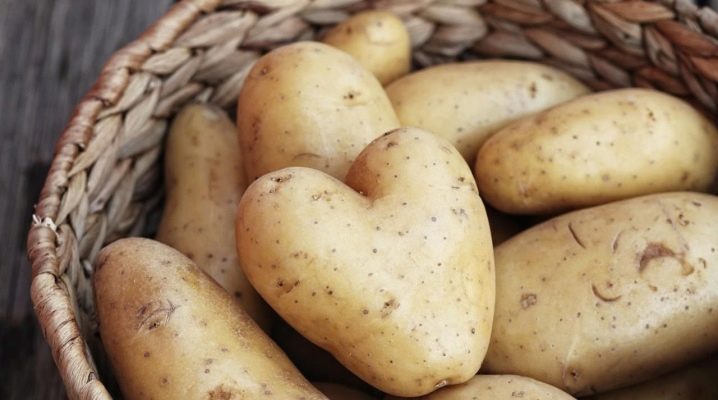
Potatoes, perhaps, are an indispensable product for both everyday and festive menus. The potato crop usually falls at the beginning of autumn, which is why summer residents face an important question - how to preserve potatoes in winter. For this, a place must be selected in which the crop does not freeze, rot, does not sprout, and at the same time retains its nutritional value.
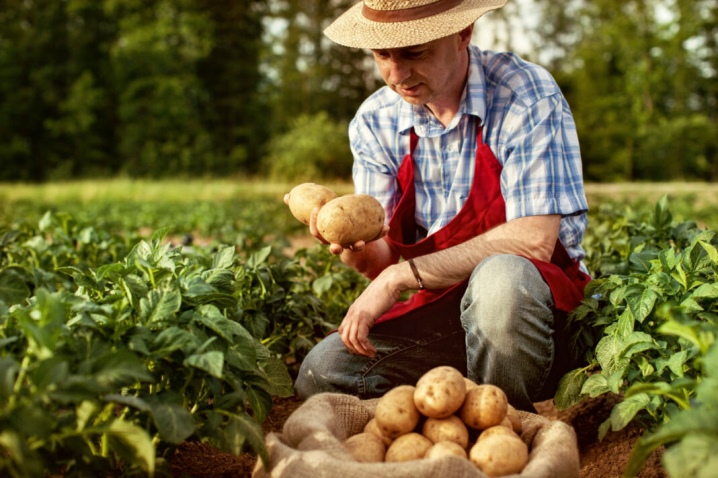
Optimal conditions
Vegetables in stores are available year-round, so many people simply buy potatoes as needed and keep them in the pantry, kitchen cupboard, or refrigerator. But if you grow vegetables on your personal plot, then in order to preserve the harvest, you need to create suitable conditions under which the food supply does not deteriorate and does not lose its nutritional value.
A well-chosen storage location significantly increases the storage period of the tubers.
Let us dwell in more detail on the conditions for preserving the young crop of potatoes.
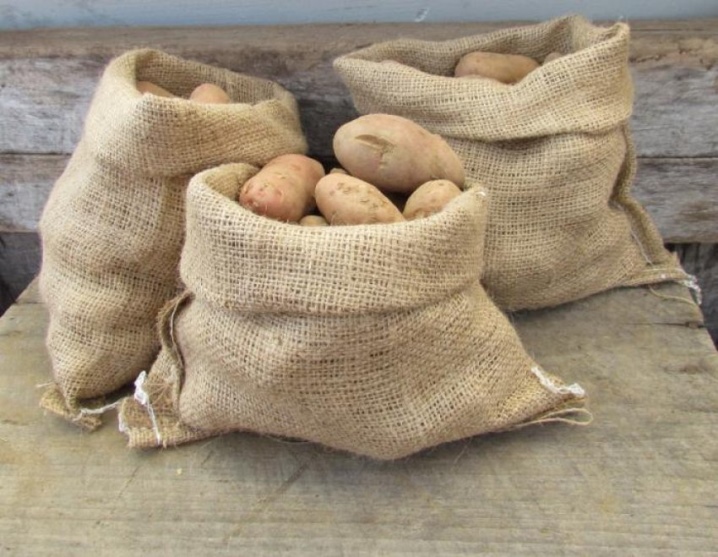
Humidity
The allowed humidity level should be 80-90%. If the humidity is increased, especially in warmth, the tubers will begin to give young shoots. This dries out the root vegetables and impairs their taste.
To achieve optimal hydration, you must:
-
regularly ventilate the block where food supplies are stored;
-
maintain full air circulation;
-
do not place boxes near walls and other surfaces where condensation accumulates;
-
keep potatoes away from places where moisture evaporates;
-
shift vegetables with sawdust to absorb excess water;
-
keep root vegetables separate from any other fruits, the only acceptable neighbor is beets.
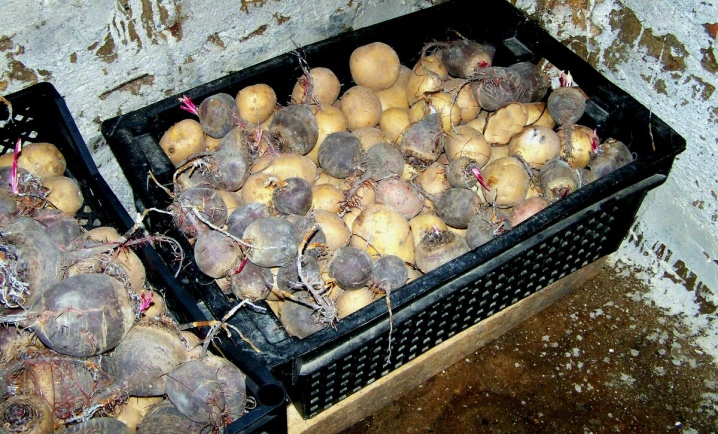
Temperature
Potatoes react badly to heat, they need coolness. It is best to keep the tubers at a temperature of + 2 ... 7 degrees, however, it is quite difficult to ensure this level in an apartment. To achieve the desired keeping quality, resort to the following measures:
-
during September-October, potatoes are placed on the balcony so as to exclude direct sunlight;
-
as soon as the air temperature drops to 2 degrees, the vegetables are transferred to the apartment;
-
the coldest areas are selected for winter storage; potatoes should not be placed near heating radiators and other sources of heating.
If you maintain an optimal humidity and temperature regime, then the potato crop will be stored for up to six months, otherwise the tubers will lie no longer than three to four weeks.
It should be borne in mind that exposure to cold weather leads to a deterioration in the taste of the fruit. With a temperature background below +2 degrees, the tubers freeze and become completely unsuitable for cooking.
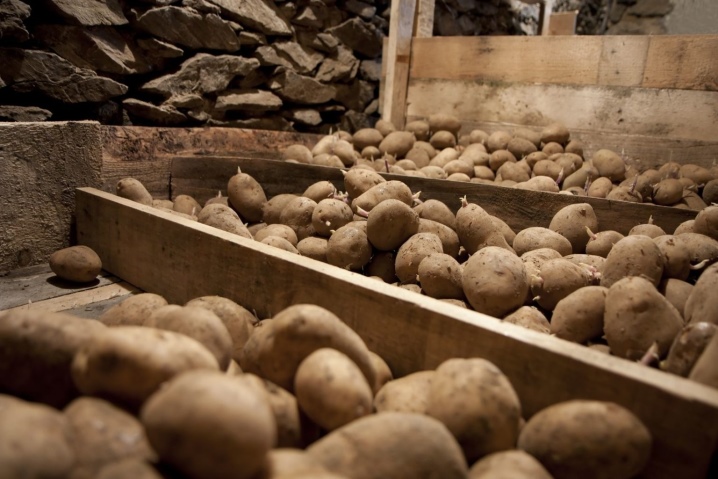
Illumination
Store vegetables only in a dark place. If they are kept on a loggia or balcony, then the boxes should be closed with linen or a piece of plywood.
Solanine accumulates in potatoes under the influence of ultraviolet rays. It is a poisonous substance that often causes cancer. You can distinguish such a potato by its green tint; it is unsuitable for eating.
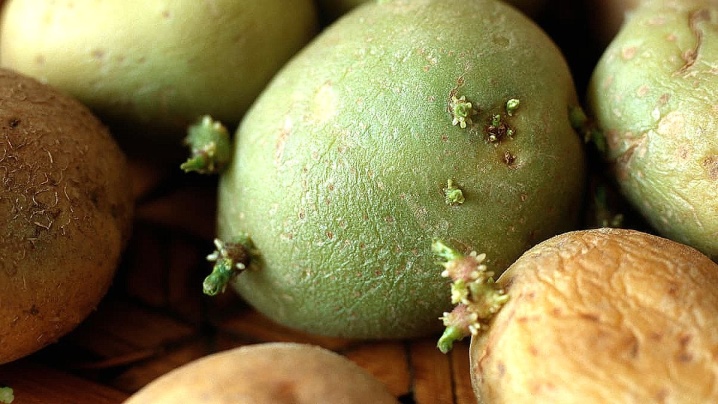
Air access
Areas with full circulation of air masses are suitable for storing potatoes. Therefore, from time to time it is necessary to arrange ventilation in the pantry - this will significantly reduce the amount of condensate, neutralize it and lower the temperature.

Types of containers
The selection of containers is one of the key points in the correct storage of vegetable stocks during the winter months.
Here's what you can use for this.
-
Linen bag - this material allows air to pass freely and thereby allows vegetables to "breathe".
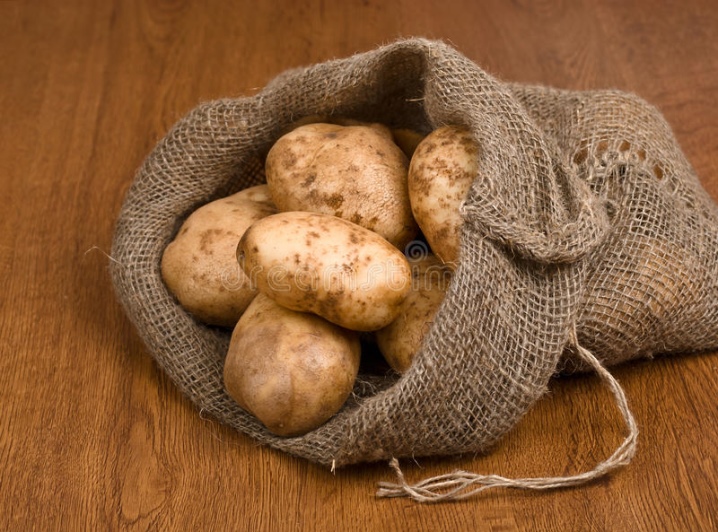
- Nylon mesh - a good container for storing root crops. Moreover, it is affordable and inexpensive.

- Boxes - any wooden boxes made of beams, boards or shields.

- Plastic container - a container that, depending on the volume, can accommodate a different number of tubers. Must include holes.
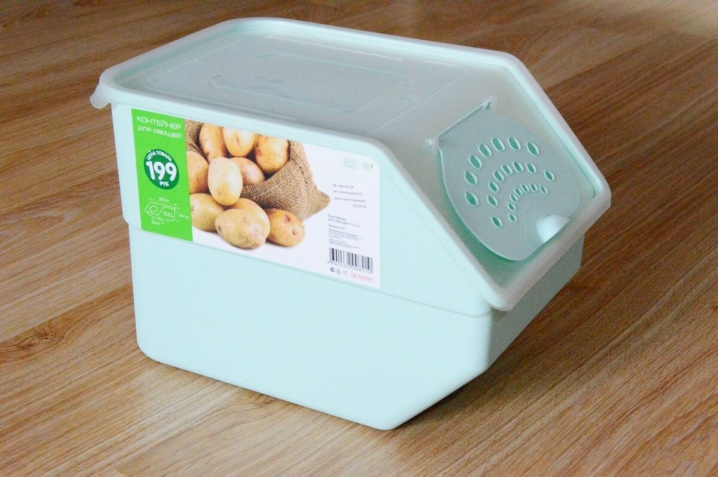
- Wicker baskets - one of the most successful solutions. The container is well ventilated, thereby preventing the formation of rot.
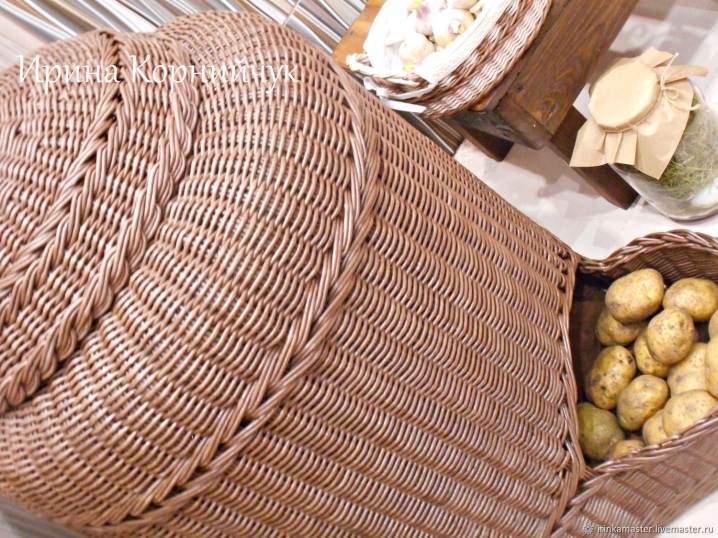
The most widespread are bags and boxes - they fully meet all the requirements for storing potato tubers.
At the same time, they are durable and, if properly processed, can serve for more than one season. But the plastic container is contraindicated, since it does not provide full ventilation. As a result, food begins to rot and becomes moldy; these vegetables should not be eaten.

Tuber preparation
Before placing for long-term storage, young tubers must be properly prepared. This requires drying - it is done immediately after harvesting. The tubers are kept in the sun for two to three hours. This time is quite enough for the potatoes to dry completely, and all excess moisture has evaporated from them. Such measures prevent decay.
Then, for about a month, the harvested crop is stored in a dry, well-ventilated dark place. During this time, the roots fully adapt to the conditions of winter storage. At this time, the temperature regime should be maintained at + 12 ... 20 degrees and the humidity should not exceed 90%. If the potatoes start to sprout, they must be removed immediately.
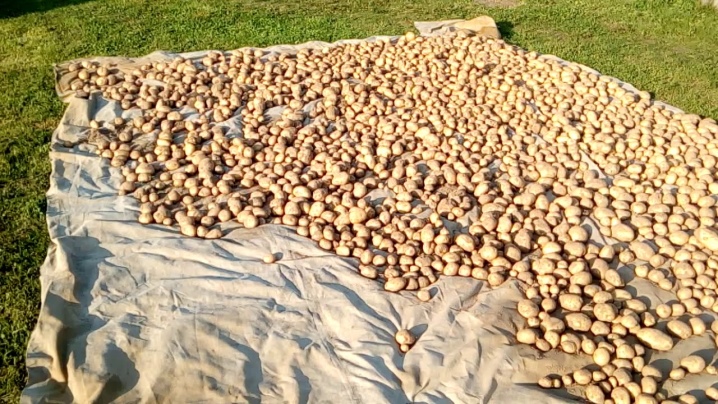
After that, the potatoes are moved to a permanent storage place and the temperature there is maintained at + 2 ... 7 degrees. Scientists have found that tubers have the ability to "breathe", that is, they emit heat, carbon dioxide and even moisture. If the room is too warm, then the vegetables will quickly lose their moisture, begin to dry out and wrinkle. To prevent the appearance of putrefactive bacteria and other pathogenic microflora, potato tubers are covered with fresh leaves of mountain ash and wormwood. From time to time, you should sort out all damaged potatoes.
The weather during the growing season, the composition of the soil and the fertilizers used play an important role. So, if the summer was rainy, then the tubers deteriorate much faster.
The use of a large volume of nitrogen fertilizers significantly impairs the keeping quality of vegetables - in this case, potatoes practically do not resist diseases.
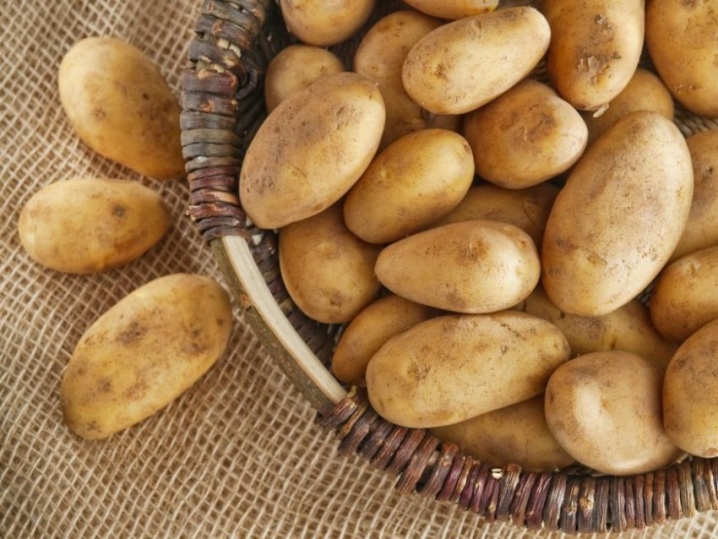
Before storing the crop, you need to sort the tubers. Small ones are separated from large ones, and they also choose vegetables that have marks from harvesting equipment or shovels. Food with damaged skin should be used for cooking immediately.
For winter storage, be sure to pay attention to varietal characteristics. Mid-early and mid-season varieties ("Rocco", "Aurora" or "Hostess") are usually stored for no more than 2 months. For longer storage, use late-ripening varieties ("Gatchinsky", "Atlant", as well as "Slavyanka").
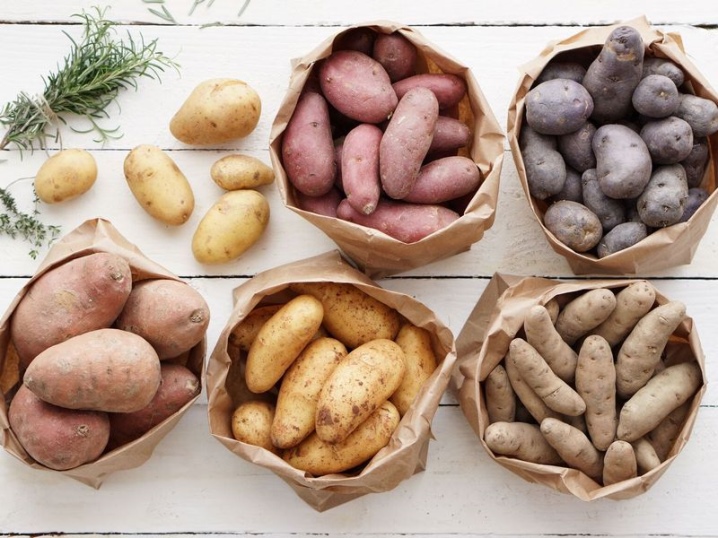
Storage methods
The apartments of the majority of Russians cannot boast of a large area, so the place for long-term storage of vegetable stocks is limited here. In addition, you are unlikely to find living quarters where the temperature does not exceed +7 degrees, and the humidity is kept within 80-90%. As a rule, root vegetables are stored in the pantry or, if there is none, in the kitchen. Alternatively, you can place vegetables on the balcony and loggia, use the refrigerator, or even put it in the entrance. Each method has both advantages and disadvantages.
On the balcony
One of the most convenient storage options for potatoes is a glazed balcony. It is best to use a wooden box or a container insulated with foam plastic for storing tubers. Additionally, the container should be wrapped in any warm clothes.
If the loggia is open, then you will have to monitor the weather and ambient temperature all the time so that the tubers do not freeze. In this case, it is better to give preference to a two-layer container preparation technique. To do this, you need to take a couple of wooden boxes of different sizes. A layer of straw is poured onto the bottom of a larger container and a smaller box filled with tubers is placed inside. The voids between the containers are also sprinkled with sawdust and the structure is additionally covered with a warm blanket. It is optimal that containers differ in size by 10-20 cm in height, as well as in length and width. In such conditions, the crop can be kept up to -15 degrees.

On the kitchen
On frosty days, potatoes are usually placed in the kitchen, especially in houses where there is no garage, basement and balcony. This is convenient, because in this case the products necessary for cooking are always at hand. However, at the same time, the temperature regime in the kitchen should not exceed +19 degrees. Therefore, the optimal solution would be the area under the sink; it is advisable to place the potatoes in a wicker basket or wooden container in order to provide full ventilation.
To eliminate excess moisture and condensation from the washing space and prevent the appearance of rot, the tubers must be shifted with branches of mountain ash, wormwood or dry mint.
As an option, you can place potatoes in the lower block of the table or pencil case. Some stores even offer special cabinets with compartments for storing vegetables. They are provided with ventilation holes for unhindered circulation of air masses. Such functional furniture helps to preserve the potato crop, moreover, it will always be in the access zone. One cabinet holds up to 20 kg of potatoes.

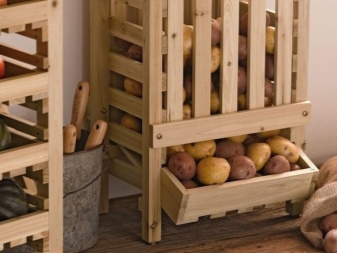
In fridge
Placing potatoes in the refrigerator is one of the most effective solutions for short-term storage of a small supply of vegetables. Modern models of technology allow you to adjust the temperature at your own discretion. Usually potatoes are stored in a bag - this allows you to protect them from any extraneous odors.
The disadvantage of this solution is the keeping of potatoes without air access. As a result, potato starch begins to break down into sugars, and vegetables become sweetish. In addition, it should be borne in mind that it is unlikely that it will be possible to place more than 5-7 kg of potatoes on the shelves of the refrigerator. Therefore, this option can be called acceptable, but by no means the most practical. Agree, you are unlikely to want to fill the entire refrigerator with potato tubers alone.
In many Soviet-built houses, a "Khrushchev box" is provided under the kitchen window. It maintains an optimal temperature background, which is suitable for storing vegetables. However, it is impossible to store the crop here when the frost is too strong, therefore, when the cold outside is below -20 ° C, it is better to remove the potatoes to another place.
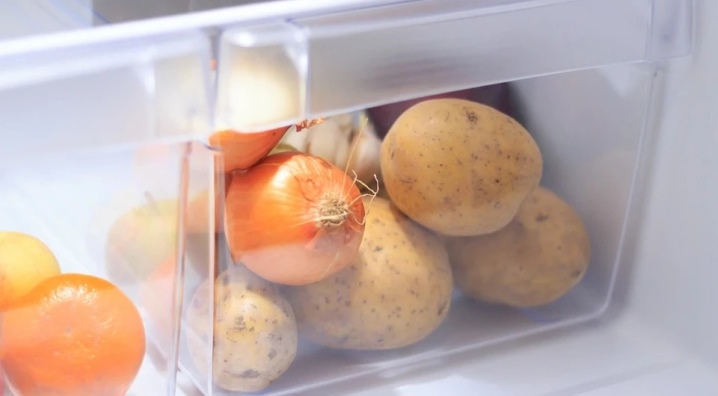
At the entrance
If there is no room in the apartment, then you can keep the harvest of vegetables in the entrance or corridor. The optimal solution would be a vestibule for two or three apartments with a tightly closing door.
And so that the neighbors do not encroach on your food supplies, they hang a lock on the box, and the box itself is attached to the floor with self-tapping screws or nails.
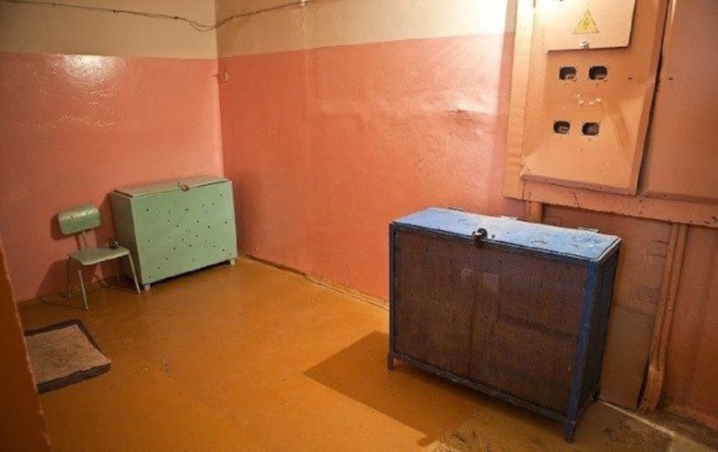
In the basement
The best solution for storing root crops will be basements. Some residents of apartment buildings have their own cellars, most often they are located outside the house. The only exceptions are residents of the first floors, who can go into the subfloor directly from the loggia.
Such places have optimal parameters of humidity and temperature level, they do not have access to direct sunlight. Therefore, a large supply of vegetables can be stored here.Placing potatoes in a subfield allows you to preserve the maximum nutritional value of root crops for at least 5-6 months. Some keep potatoes not only until spring, but even until the next harvest.
However, the cellar needs to be prepared. To do this, it is thoroughly dried, ventilated and disinfected. Optimally cover shelves, walls, floors and ceilings with lime. Be sure to clean the shelves, stairs, and vents from cobwebs and dust. It is important that the cellar is sufficiently thermally insulated and at the same time has holes for condensate drainage.
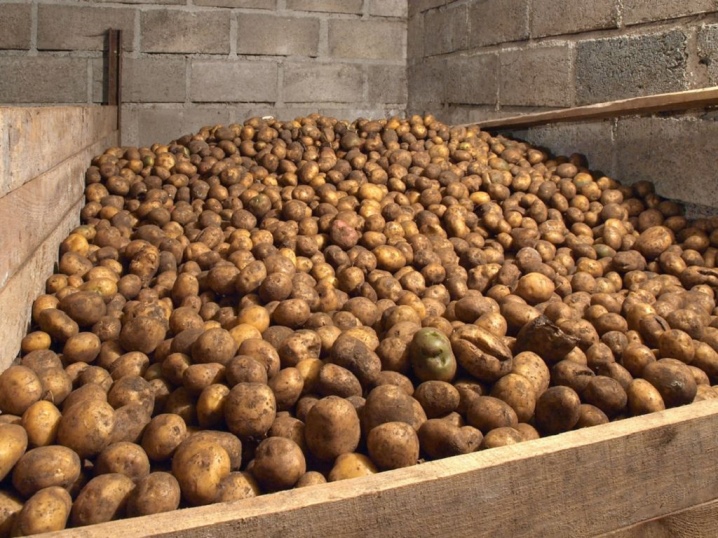
How to increase the shelf life?
An apartment cannot be called the most practical solution for long-term storage of potatoes. But if you wish, you can find an optimal place in every home that will allow you to keep food supplies for several months. To keep the potatoes as long as possible, you need to properly handle the containers in which you plan to place the vegetables. It is best to disinfect them with bleach or copper sulfate solution, and then dry thoroughly.
Laying rows of potatoes with straw or sawdust significantly increases the keeping quality of products. From above, the container is covered with spruce branches. A good result is provided by a row of beets laid out on top - this root vegetable absorbs all excess moisture. Experienced summer residents are advised to put dried lemon balm branches in a container with potatoes. It is noticed that in this case the tubers will not sprout for a long time.
Ginger roots, onion skins and ferns help keep vegetables as long as possible.
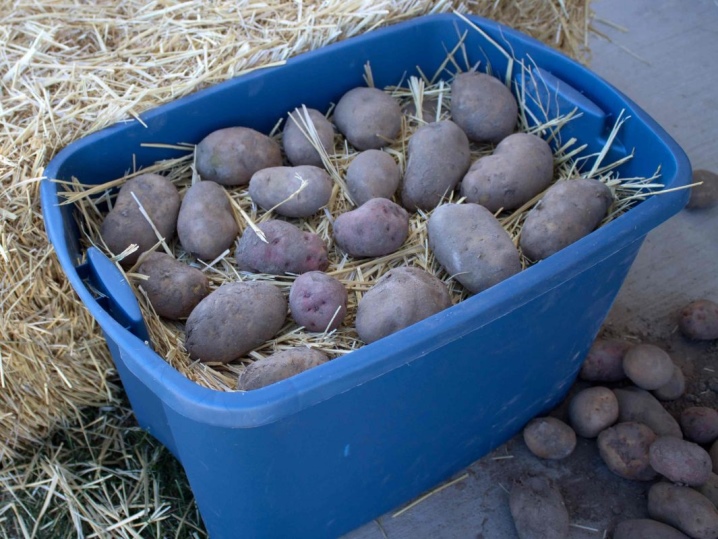
In conclusion, we note that there are no difficulties in storing potato tubers at home in winter. But sometimes it happens that the crop is still deformed, starts to rot or dries up. The reasons for this can be very different.
-
Insufficiently careful sorting, as a result of which damaged tubers ended up in the total mass of stocks.
-
Early maturing varieties were selected for storage, which were not intended for this purpose.
-
Other vegetables were kept near the potatoes.
-
The humidity parameters were not observed, and the temperature regime was violated.
-
The food storage area was not sufficiently prepared.
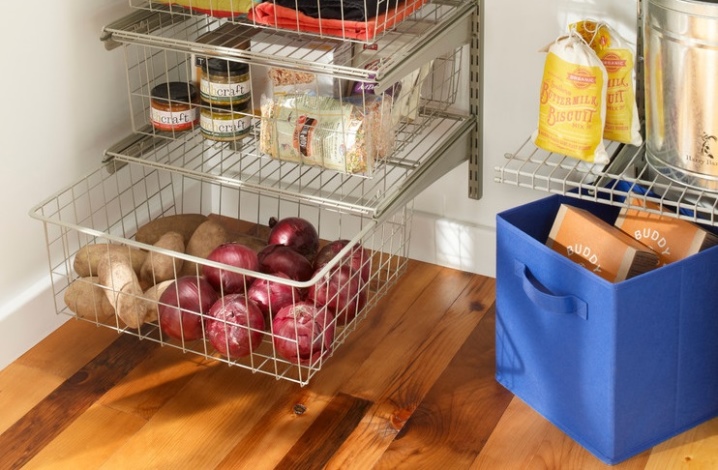













The comment was sent successfully.